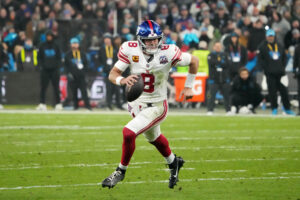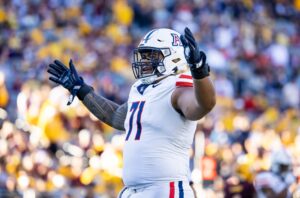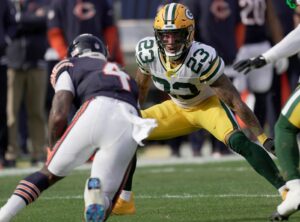At this point it should come as no surprise to anyone that running back changes will happen. This is due in part because there are changes to starters and depth every year. That would be like watching an episode of The Simpsons and being shocked that they did a different couch gag. So you shouldn’t be surprised to hear that the NFC North will not be immune to such changes in 2018.
(All contract information is from Over The Cap. All statistical data is from PlayerProfiler.)
NFL Running Back Changes for 2018 – NFC North Edition
Chicago Bears
The Bears rushing attack had a number of obstacles to overcome: most notably, the infamous John Fox. Fox’s biggest achievement last year was growing a beard. Perhaps he chose to grow it in attempt to hide in plain sight. Or he grew it (and here’s your fun fact for the day) because it can get cold in Chicago. Either way, the great Fox presided over an offense that ranked 18th in rush attempts and 32nd in pass plays. In other words, their rushing game struggled to overcome the predictability of their offense, and their team struggled as a result.
Starting Options
Jordan Howard doesn’t have the most impressive athletic profile. He does, however, have production at the pro level. Howard rushed for 1,314 yards in 2016 (second best) and followed that up with 1,112 yards in 2017 (sixth best). Howard also only counts $692,006 against the cap right now. While his rushing production and his cost make it highly unlikely that the Bears choose to find a different starter, Howard does have his limitations as a player. Most notably is his receiving ability. Last year he had six drops on only 32 targets. That’s, to put it kindly, less than good.
Depth
The good news is that not all of the options in the Bears backfield have hands made out of worn out velcro paddles. Tarik Cohen, the best of those options, is a great complement to Howard.
First, Cohen is a better receiver, which isn’t much of a stretch here, but Cohen can catch two balls while doing a backflip. I’m not exactly sure when that skill will ever come in handy, but rest assured that if American Gladiators ever made a comeback, Cohen would tear that show apart. Over the course of 2017, Cohen saw 71 targets and had 356 receiving yards as a rookie.
Second, Cohen is a shiftier, more dynamic athlete. Howard may do a good job of reading his blocks and breaking the occasional tackle, but Cohen is more dangerous in space. Now that Benny Cunningham is an unrestricted free agent, it’s possible that Cohen will secure more of the third-down work going forward.
The team also has Taquan Mizzell on their roster, but he has yet to see a touch in an NFL game.
Overall
Depending on what the team does about Cunningham, there likely isn’t going to be much change with the Bears backfield. Howard will still be the starter. And Cohen should be the third down back. The only thing the Bears could look into is adding to their depth by signing a cheap free agent or using a late round draft pick on the position.
Detroit Lions
In a world of uncertainty, the Lions running game remains a constant. Any Lions fan would likely add on “a constant piece of [The Emoji Movie]” (keeping things PG here) out of frustration with the team’s production. And that frustration is not misplaced. According to NFL.com, the Lions in rushing yards per game have finished 32nd, 30th, 32nd, 28th, and 17th (hooray?) in the last five years. In fact, in order to find a season where the Lions finished in the top 10 in rushing, you would have to go all the way back to 1998. That’s right; 1998. The year when Sean Combs still went by Puff Daddy, Chumbawamba was a thing, and Barry Sanders played his last down for the Lions. To say that there is room for improvement here is an understatement.
Starting Options
This is hardly a spoiler, but a team that finished 32nd in rushing is likely going to look to change things up at the position. Last year, Ameer Abdullah led the team with 165 carries and finished with 552 rushing yards. Those are disappointing numbers for the SPARQ dynamo (98th percentile).
Theo Riddick was second on the team in carries (84) and rushing yards (286), which are hardly impressive numbers. However, he did have 444 receiving yards and he bested Abdullah in evaded tackles and juke rate. In short, despite the limited amount of carries, Riddick was the more productive back last year.
In order to get out of the mess the Lions have found themselves in, they are going to have to answer a number of tough questions. For instance, is Riddick’s production worth over $4.1 million? The team could designate Riddick as a post-June first cut and save over $3.1 million towards the cap.
Whatever they decide to do with Riddick or Abdullah, the Lions are in prime position to shake things up. Their general manager Bob Quinn has even said that he expects to add a running back this off-season. How they will add the back is anyone’s guess at this point. They could choose to sign a free agent. However, the current size of cap space (around $44.7 million) is a little misleading. Free agents like Ezekiel Ansah, if the team re-signs him, would likely eat into that number pretty quickly. That puts higher priced free agents like Carlos Hyde likely out of reach. Using a draft pick on a running back is also an option. The team currently sits at the 20th spot in the draft and they could see a number of enticing names on the board in the early rounds.
Depth
Tion Green did his best Kool-Aid Man impersonation by crashing the Lions backfield party in weeks 13 through 17. The former Cincinnati Bearcat plodded his way to 165 rushing yards in those games and will only cost the Lions about $556,000 to keep for next year. If the team decides he’s no longer a good fit, they would save roughly $555,000 towards the cap.
Dwayne Washington ranked fifth on the team in carries with 20 rushes in five games. In comparison to Green, Washington has a better athletic profile. And yet, the former Washington Husky has only seen over 15 carries in a game once in his career so far. Washington has also put up pretty pedestrian efficiency numbers over the past two seasons (3.3 and 2.2 yards per touch in 2016 and 2017), so the Lions probably don’t have designs for him to become their next starter. If Washington is on the roster next year, he will cost close to $650,000. If the Lions choose to move on from him, they would save roughly $611,000.
Zach Zenner, who is currently a restricted free agent, had a disappointing season last year. He only had 14 carries and 26 rushing yards. The fact that Quinn wants to add a new back to their depth chart likely means Zenner is the odd man out.
Overall
The Lions need to improve their running game. The team knows it. The fans know it. The general manager knows it. In order to improve, the Lions are faced with essentially four choices. First, give Abdullah the reins (unlikely). Second, do nothing and pretend that the Riddick-Abdullah combo will work out (also unlikely). Third, sign a free agent running back who can turn their rushing fortunes around (more likely than the first two options). And fourth, draft a prospect in the first four rounds (likely but dependent on how free agency plays out).
Green Bay Packers
If there was one word that could help to summarize the Packers season, it would be “injury.” Of course, there is the obvious Aaron Rodgers injury and its impact on the team. There were also injuries to Ty Montgomery, Aaron Jones, and Jamaal Williams. In other words, their entire rushing attack. So it’s easy to see how the season didn’t play out the way that they intended. And how those complications have created potential chaos for the 2018 season (at least for prognosticators).
Starting Options
Speaking of potential chaos, the biggest question for the Packers and their backfield is who will start? Going into 2017, Montgomery was the lead back, and things were going pretty well. He was proving to be dynamic as both a runner and a receiver, which put more pressure on opposing defenses. Montgomery’s ribs, however, weren’t able to hold up to the increased workload. After the fifth week (the week of his injury), Montgomery only had more than 10 touches in a game once. The injury and his usage afterwards suggest that the starting job will most likely come down to Jones or Williams.
Jones was the next back to step up after Montgomery’s injury. The former UTEP Miner exploded onto the scene with 134 total yards in his first start in week five. The rest of Green’s time as the starter looked like a rollercoaster. He followed the 134 yards up with 39, then 138, and then 11. Jones suffered an MCL injury in the following week, which cost him three games. When Jones returned, he returned to a backup role.
Williams’ time as the starter, in comparison to Jones, proved to be a more consistent one. His yardage totals of 95, 135, 123, and 118 followed by predictable down games (30 and 58) against tough defenses suggested that Williams has a leg up on his competition for the starting role in 2018.
The main problem with simply assuming that the Packers will simply hand Williams the starting role is that while Williams might have been more consistent, he was less efficient than Jones. In comparison, Jones bested Williams in a number of metrics–yards created, juke rate, and yards per touch while Williams proved to be the better receiver out of the backfield. There is simply too much time until the season starts to declare who will win out of these two.
Depth
Whoever doesn’t win the starting job will obviously slide on down to providing depth at running back for the Packers. Although, LWOS writer Jim Weidner points out that the Packers could move Montgomery back to wide receiver if Randall Cobb is cut.
Devante Mays and Joel Bouagnon help to round out the rest of the depth for the team. As long as Williams and Jones are healthy, neither of the aforementioned players should see a healthy amount of carries in 2018.
Overall
The biggest thing the Packers need to figure out, with regards to their running backs, is who they will pick to start between Jones and Williams. Jones is the more explosive, efficient option, while Williams is more consistent.
This team invested three picks at the position last year, which makes them cost effective and young. In other words, the team doesn’t have much of a driving force to grab another running back. If Montgomery is moved to wide receiver, however, the team could look to replace him with a late round option. Outside of that possibility, what you see here is likely what you will get.
Minnesota Vikings
At the start of the season, the Viking rushing attack looked like it was going to be the Dalvin Cook show. Then that all changed in week four when Cook tore his ACL. After Cook’s injury, SPARQ freak, otherwise known as Jerick McKinnon, and Latavius Murray took things over. Despite the sourness of losing Cook, McKinnon and Murray, combined with the offensive line investments, were able to turn the rushing attack around. According to NFL.com, the team finished dead last in rushing yards in 2016 while in 2017 they finished seventh best in the league. Vikings fans are obviously hoping their rushing attack continues to impress next year.
Starting Options
As far as starters go, if Cook is healthy, this is his gig. End of story. If he’s not healthy, well, then that’s where things get interesting. As it stands now Murray is set to make $6.35 million, which is a huge amount to pay a backup. In fact, that’s currently the sixth highest amount for a running back in 2018. So if Cook isn’t healthy, the Vikings have an interesting decision to make regarding Murray. If Cook is ready to go, the Vikings could free up $5.15 million by releasing him.
Depth
McKinnon is an unrestricted free agent right now. And while his skill set compliments Cook really well, McKinnon has stated that he prefers to be the featured back. In other words, he likely won’t be back.
Mack Brown is the only other running back on the roster right now, which makes the Vikings a safe bet to add to their depth this off-season.
Overall
Dalvin Cook has the potential to be special, which makes Murray’s contract an easy one to move on from. With McKinnon (and possibly Murray) potentially gone, the Vikings will need to add to their depth. Specifically, they will need to find a satellite back/receiving back in either free agency (e.g. Chris Simms or Shane Vereen) or in the draft (e.g. Nyheim Hines or Ito Smith).






